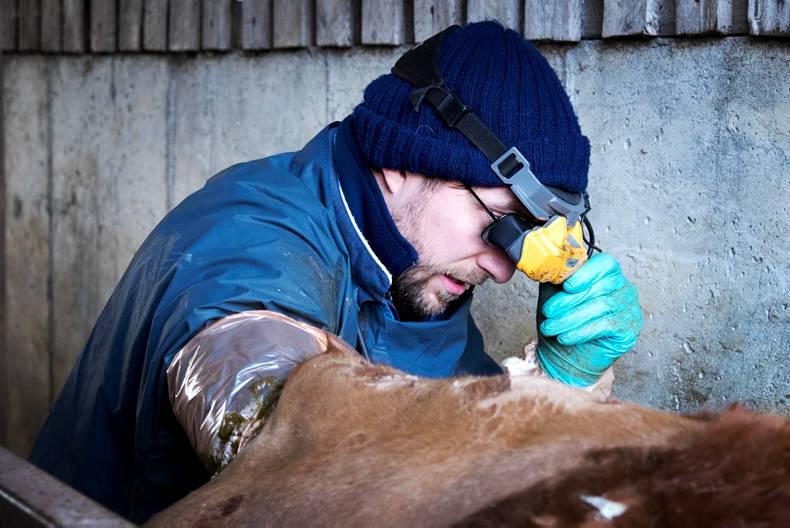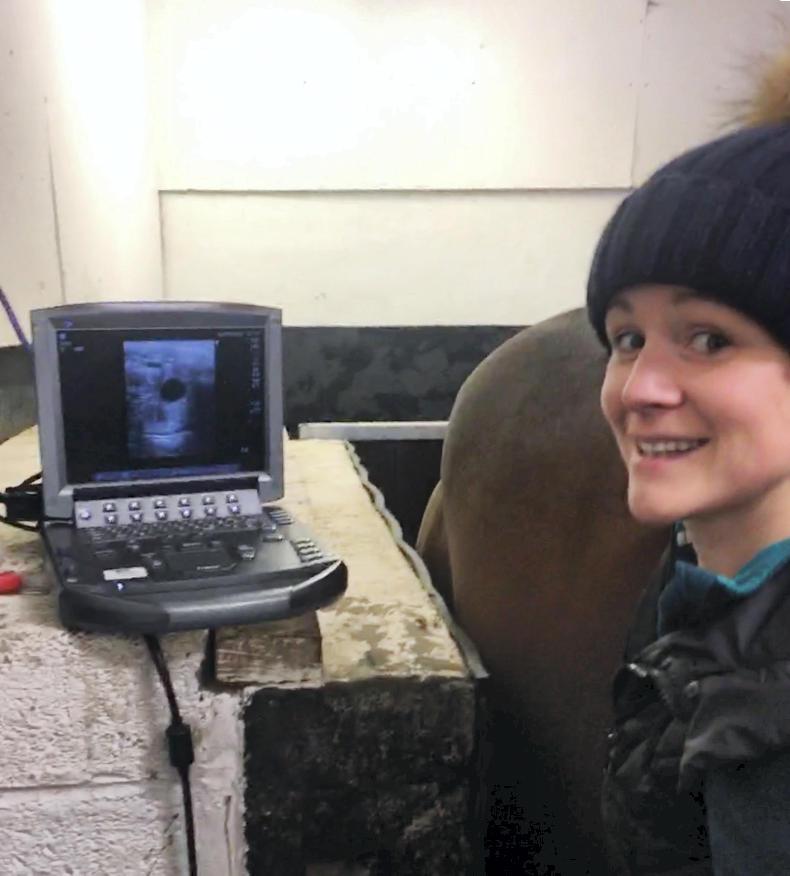Synchronisation of the oestrus cycle has the potential to shorten the calving season, increase calf uniformity and enhance the possibilities for utilising artificial insemination (AI) in beef breeding.
As reproductive technologies go, AI and synchronisation remain the most important and applicable for suckler farmers. However, despite their noted benefits, the adoption and use of these technologies at farm level has been slow.
Current figures in Ireland reveal that as few as 17% of calves born to beef cows are sired through AI, and less than 50% of pedigree beef cows are bred this way. The time, logistics and labour commitment associated with heat detection limits the more widespread application of AI programmes on beef farms.
Indeed, the decline in AI and low usage rates do not bode well for the rapid improvement of maternal traits of the national beef cow herd currently being planned by the Irish Cattle Breeding Federation (ICBF).
For maternal and fertility traits, the use of AI is central to improvement as it allows farmers the opportunity to accelerate genetic progress through targeted breeding of replacement heifers from genetically superior sires with the highest reliable breeding values for maternal traits.
New synchronisation fixed-time insemination (FTAI) protocols
This new generation of synchronisation protocols uses two strategies that are key factors for use by producers because they (i) minimise the number of animal handlings (max three interventions including AI), (ii) offer the option to eliminate the need for heat detection by using fixed time AI, and (iii) facilitate the potential use of sex-sorted semen.
Previously, the lack of synchronisation of oestrus and ovulation, and variable/poor conception rates were a major constraint of early protocols. This precluded fixed-time AI reaching acceptable pregnancy rates. However, in recent times our understanding of follicular dynamics and the regulatory mechanisms controlling follicular growth has increased considerably. This has led to the development of new methods.
These protocols increase the proportion of cows that become pregnant on the first day of the breeding season and also increase the number of calves sired by genetically superior AI sires.
For beef cows suckling their calves, the only viable hormonal treatment for synchronisation of oestrus is a progesterone-based treatment. Of the synchronisation protocols currently used for suckled beef cows, CO-Synch (ie GnRH-progesterone-prostaglandin based) tends to be more cost-effective and less labour-intensive than others.
This regimen (Figure 1) is based on three separate interventions including a CIDR or PRID and is as follows: insert an intravaginal progesterone-releasing device (eg PRID or CIDR) for seven days, and inject with prostaglandin (PGF) at time of insert removal; required to ensure corpus luteum regression.
The use of GnRH (Receptal) at the start of the progesterone treatment is recommended to induce a new follicle wave emergence and to ensure that a recruited dominant follicle is present at insert removal – important for high pregnancy rates following AI. For fixed-time AI, inseminate between 72 hours (about 2.5 days) post-CIDR or PRID removal and inject with GnRH at time of insemination (day 10 of the protocol).
BEEFCOW Fertility Project
BEEFCOW is the largest suckler fertility project ever undertaken in Ireland. Funded by the Department of Agriculture, Food and the Marine (DAFM), this project aims to examine the root causes of poor fertility in Irish suckler herds. This is a collaborative project led by Teagasc (under Prof David Kenny) with support from key industry stakeholders such as UCD, AFBI, DAFM, ICBF and the Irish Farmers Journal.
As part of the project, a robust cost-effective synchronisation regimen to increase usage of AI in Irish beef cows through the use of fixed-time AI was established. To this end, a series of large-scale on-farm synchronisation studies for FTAI were conducted in 2014 and 2015 across 74 beef cow herds all over the island of Ireland. The trials were run in both autumn- and spring-calving herds.
In total, 2,205 suckler cows were enrolled in the studies. All cows were 42 days calved at AI. Herd data collected included age/parity, breed type, days after calving, previous level of dystocia and body condition score at breeding. Mineral status and exposure to various infectious diseases that reduce cow fertility were also examined. The conception rate of cows was determined 30 to 35 days post-AI by detailed scanning.
Additionally, these studies will also form the basis of UCD postgraduate student Federico Randi’s PhD thesis.
On-farm FTAI results
After two years of intensive studies, results show overall pregnancy rate impressively ranges from 54% to 57% across the synchronisation protocols. These results are very much on par with US studies, which consistently achieved pregnancy rates of greater than 50% on well-managed beef herds.
The highest pregnancy rate (57%) was achieved on a standard Co-synch protocol plus eCG (Co-Synch+eCG). The low dose of eCG at the time of insert removal was most effective for anestrus (non-cycling) cows and it increased conception rate by seven percentage points for this group. Indeed, it is interesting to note that nearly half the cows used in this study were non-cycling at the start of the breeding season.
For the spring 2015 studies, the synchronisation treatments were combined with the introduction of a stock bull 10 days after FTAI to monitor fertility at subsequent repeat heats. The results from this dual approach were extremely impressive and showed that by implementing this strategy, 78% of cows could be pregnant after only 23 days of breeding.
Cost is always a question that revolves around synchronisation programmes. Typical costs of a synchronisation programme range from €25 to €30 per cow treated. However, there is some negotiation here with vets and AI companies if a large number of cows could be treated at the one visit. Remember, failure to maintain a 365-day calving interval is estimated by ICBF to cost the production system €2.70 per cow/per day.
Given the average calving interval is greater than 400 days on Irish beef farms, reducing this will more than offset the cost in most cases, not to mention the added labour benefits.
Drivers of success
Synchronisation requires more intensive management of the cow herd and should only be used in herds where the level of management and skill are high. From our experience, there are several management factors to consider before deciding whether synchronisation and FTAI will work in your farming operation.
Nutrition: The pre-calving nutritional diet and body condition at calving determines the rate cows start their oestrus cycle after calving and ultimately the number of anestrus (non-cyclic) cows at the start of the breeding season. The simplest method to overcome anestrus is to ensure that cows are maintained on a sound nutrition regimen both pre- and post-calving. To enhance the success rate with a synchronisation programme, ensure that cows are in good condition at calving. It is recommended that cows should have a moderate body condition score (BCS 2.5-3) at the time of treatment and are on a good plane of nutrition (plentiful supply of high nutritive value early spring grass), for a minimum of one month prior to, during and after the synchronisation programme. Also, to maximise the success rate, it is important that cows are a minimum of 35 days calved prior to initiating treatment. Data recording and animal events: Maintaining an accurate and easy-to-follow recording system is important in any reproductive management system. HerdPlus or animal event recording systems are ideal for this purpose. Knowing when the cow calved or if she had a difficult birth are the starting points for synchronisation programmes to work and all subsequent decisions.Facilities: With synchronisation, more cows are in heat at the one time, along with the more frequent movement of cows for injections. Also, added demand is put on calving facilities. As such, on-farm facilities like cattle pens, cattle race and head-gates all come under more pressure than normal. To work successfully, your on-farm facilities need to be able to accommodate the extra work demand associated with these programmes.To read the full Beef Breeding Focus Supplement click here
Synchronisation of the oestrus cycle has the potential to shorten the calving season, increase calf uniformity and enhance the possibilities for utilising artificial insemination (AI) in beef breeding.
As reproductive technologies go, AI and synchronisation remain the most important and applicable for suckler farmers. However, despite their noted benefits, the adoption and use of these technologies at farm level has been slow.
Current figures in Ireland reveal that as few as 17% of calves born to beef cows are sired through AI, and less than 50% of pedigree beef cows are bred this way. The time, logistics and labour commitment associated with heat detection limits the more widespread application of AI programmes on beef farms.
Indeed, the decline in AI and low usage rates do not bode well for the rapid improvement of maternal traits of the national beef cow herd currently being planned by the Irish Cattle Breeding Federation (ICBF).
For maternal and fertility traits, the use of AI is central to improvement as it allows farmers the opportunity to accelerate genetic progress through targeted breeding of replacement heifers from genetically superior sires with the highest reliable breeding values for maternal traits.
New synchronisation fixed-time insemination (FTAI) protocols
This new generation of synchronisation protocols uses two strategies that are key factors for use by producers because they (i) minimise the number of animal handlings (max three interventions including AI), (ii) offer the option to eliminate the need for heat detection by using fixed time AI, and (iii) facilitate the potential use of sex-sorted semen.
Previously, the lack of synchronisation of oestrus and ovulation, and variable/poor conception rates were a major constraint of early protocols. This precluded fixed-time AI reaching acceptable pregnancy rates. However, in recent times our understanding of follicular dynamics and the regulatory mechanisms controlling follicular growth has increased considerably. This has led to the development of new methods.
These protocols increase the proportion of cows that become pregnant on the first day of the breeding season and also increase the number of calves sired by genetically superior AI sires.
For beef cows suckling their calves, the only viable hormonal treatment for synchronisation of oestrus is a progesterone-based treatment. Of the synchronisation protocols currently used for suckled beef cows, CO-Synch (ie GnRH-progesterone-prostaglandin based) tends to be more cost-effective and less labour-intensive than others.
This regimen (Figure 1) is based on three separate interventions including a CIDR or PRID and is as follows: insert an intravaginal progesterone-releasing device (eg PRID or CIDR) for seven days, and inject with prostaglandin (PGF) at time of insert removal; required to ensure corpus luteum regression.
The use of GnRH (Receptal) at the start of the progesterone treatment is recommended to induce a new follicle wave emergence and to ensure that a recruited dominant follicle is present at insert removal – important for high pregnancy rates following AI. For fixed-time AI, inseminate between 72 hours (about 2.5 days) post-CIDR or PRID removal and inject with GnRH at time of insemination (day 10 of the protocol).
BEEFCOW Fertility Project
BEEFCOW is the largest suckler fertility project ever undertaken in Ireland. Funded by the Department of Agriculture, Food and the Marine (DAFM), this project aims to examine the root causes of poor fertility in Irish suckler herds. This is a collaborative project led by Teagasc (under Prof David Kenny) with support from key industry stakeholders such as UCD, AFBI, DAFM, ICBF and the Irish Farmers Journal.
As part of the project, a robust cost-effective synchronisation regimen to increase usage of AI in Irish beef cows through the use of fixed-time AI was established. To this end, a series of large-scale on-farm synchronisation studies for FTAI were conducted in 2014 and 2015 across 74 beef cow herds all over the island of Ireland. The trials were run in both autumn- and spring-calving herds.
In total, 2,205 suckler cows were enrolled in the studies. All cows were 42 days calved at AI. Herd data collected included age/parity, breed type, days after calving, previous level of dystocia and body condition score at breeding. Mineral status and exposure to various infectious diseases that reduce cow fertility were also examined. The conception rate of cows was determined 30 to 35 days post-AI by detailed scanning.
Additionally, these studies will also form the basis of UCD postgraduate student Federico Randi’s PhD thesis.
On-farm FTAI results
After two years of intensive studies, results show overall pregnancy rate impressively ranges from 54% to 57% across the synchronisation protocols. These results are very much on par with US studies, which consistently achieved pregnancy rates of greater than 50% on well-managed beef herds.
The highest pregnancy rate (57%) was achieved on a standard Co-synch protocol plus eCG (Co-Synch+eCG). The low dose of eCG at the time of insert removal was most effective for anestrus (non-cycling) cows and it increased conception rate by seven percentage points for this group. Indeed, it is interesting to note that nearly half the cows used in this study were non-cycling at the start of the breeding season.
For the spring 2015 studies, the synchronisation treatments were combined with the introduction of a stock bull 10 days after FTAI to monitor fertility at subsequent repeat heats. The results from this dual approach were extremely impressive and showed that by implementing this strategy, 78% of cows could be pregnant after only 23 days of breeding.
Cost is always a question that revolves around synchronisation programmes. Typical costs of a synchronisation programme range from €25 to €30 per cow treated. However, there is some negotiation here with vets and AI companies if a large number of cows could be treated at the one visit. Remember, failure to maintain a 365-day calving interval is estimated by ICBF to cost the production system €2.70 per cow/per day.
Given the average calving interval is greater than 400 days on Irish beef farms, reducing this will more than offset the cost in most cases, not to mention the added labour benefits.
Drivers of success
Synchronisation requires more intensive management of the cow herd and should only be used in herds where the level of management and skill are high. From our experience, there are several management factors to consider before deciding whether synchronisation and FTAI will work in your farming operation.
Nutrition: The pre-calving nutritional diet and body condition at calving determines the rate cows start their oestrus cycle after calving and ultimately the number of anestrus (non-cyclic) cows at the start of the breeding season. The simplest method to overcome anestrus is to ensure that cows are maintained on a sound nutrition regimen both pre- and post-calving. To enhance the success rate with a synchronisation programme, ensure that cows are in good condition at calving. It is recommended that cows should have a moderate body condition score (BCS 2.5-3) at the time of treatment and are on a good plane of nutrition (plentiful supply of high nutritive value early spring grass), for a minimum of one month prior to, during and after the synchronisation programme. Also, to maximise the success rate, it is important that cows are a minimum of 35 days calved prior to initiating treatment. Data recording and animal events: Maintaining an accurate and easy-to-follow recording system is important in any reproductive management system. HerdPlus or animal event recording systems are ideal for this purpose. Knowing when the cow calved or if she had a difficult birth are the starting points for synchronisation programmes to work and all subsequent decisions.Facilities: With synchronisation, more cows are in heat at the one time, along with the more frequent movement of cows for injections. Also, added demand is put on calving facilities. As such, on-farm facilities like cattle pens, cattle race and head-gates all come under more pressure than normal. To work successfully, your on-farm facilities need to be able to accommodate the extra work demand associated with these programmes.To read the full Beef Breeding Focus Supplement click here










SHARING OPTIONS